- News
Prof. Honglin Wang: SJTU Meets University of Ulm & TUM – A Convergence of Clinical Practice & Research, and an expansion of Friendship & Cooperation
王宏林:SJTU meets Uni Ulm & TUM,临床与科研的碰撞,友谊与合作的拓展
I had the honor of participating in our hospital delegation's visit to Germany, led by Dean Jun Liu, from June 10 to 14. We conducted in-depth academic and clinical exchanges at the University of Ulm Medical School and its affiliated hospital, the Isar Klinikum of the Technical University of Munich (TUM), and the Klinikum Großhadern of Ludwig Maximilian University of Munich. Here is a summary of the visit:
On the morning of June 10, at 10:00 AM, an academic exchange event titled "Shanghai Jiao Tong University Meets Ulm University" was held in the multifunctional lecture hall N27 at the University of Ulm. Professor Michael Weber, President of the University of Ulm, firstly delivered a welcome address, extending a warm welcome to our delegation and providing an overview of the university’s history and basic information. Following this, Professor Thomas Wirth, Dean of the University of Ulm Medical School, delivered a welcome speech, introducing the medical school's key areas of research. Florian Gebhard, Vice President of the University of Ulm Hospital, introduced the hospital and provided detailed information about the Trauma Center, which he heads.
Dean Jun Liu of our hospital then delivered an impromptu speech in English, expressing gratitude for the warm invitation from the University of Ulm, outlining the history of the relationship between our institutions, and envisioning a promising future for our cooperation. Director Fang Liu from our International Cooperation and Exchange Office presented an impressive PowerPoint introduction, showcasing the features of our hospital’s North and South campuses, along with other campuses, highlighting our clinical and research capabilities.

Following this, the academic exchange officially commenced. I delivered an academic presentation titled “Neuroimmunopathology in Dermatological Immune Diseases,” where I vividly and comprehensively explained the role of neuro-immune interactions in the pathogenesis of skin diseases such as psoriasis, vitiligo, and keloids. Additionally, I shared my insights and experiences on translating research into products. Professor Hartmut Geiger, Head of the Institute for Molecular Medicine and Stem Cell Aging Research at Ulm University, presented on “Aging of Hematopoietic Stem Cells and Therapeutic Strategies.” He detailed his team's research on how changes in cell polarity affect the hematopoietic function of aging stem cells and the body's immune response, proposing potential strategies for enhancing hematopoietic function and extending the lifespan of mice through targeted regulation of key polarity proteins. In her academic report, Researcher Chen Sisi from our hospital shared her findings on the construction of disease models and the molecular mechanisms of the malignant transformation of pre-malignant lesions into myeloid tumors in hematologic cancers. She engaged in an in-depth exchange with Professor Hartmut Geiger on their respective teams' research experiences regarding the aging of hematopoietic stem cells and the development mechanisms of myeloid hematologic tumors.
Dr. Sebastian Iben from the Department of Dermatology at the University of Ulm illustrated, using progeria and Huntington's disease as examples, that mutations in key genes involved in the DNA repair process are the fundamental cause of these progeroid diseases. He highlighted that the resultant ribosomal dysfunction and protein misfolding are targetable aspects of these conditions. In contrast, Researcher Jiang Dongsheng from Shanghai General Hospital focused on the causes, origins, and processes of scar formation, emphasizing the decisive role of fibroblast heterogeneity in scar generation. He noted that targeting the directed migration of fascial fibroblast groups is crucial for preventing scar formation.
During the Q&A session, experts discussed the contributions of dermal fibroblast proliferation and newly generated extracellular matrix to wound healing and scar formation. Following this, Professor Karin Scharffetter-Kochanek, Head of the Department of Dermatology and Allergic Diseases at the University of Ulm and the primary German invitee of this event, as well as the former mentor of both myself and Researcher Jiang Dongsheng, delivered a report titled “Development of ABCB5+ Mesenchymal Stromal Cells in the Treatment of Chronic Wounds.” She covered topics ranging from the pathogenesis of chronic venous leg ulcers and the cellular and molecular mechanisms of mesenchymal stem cell therapy to translational research on the purification and application of ABCB5-positive mesenchymal stem cells in skin treatment.
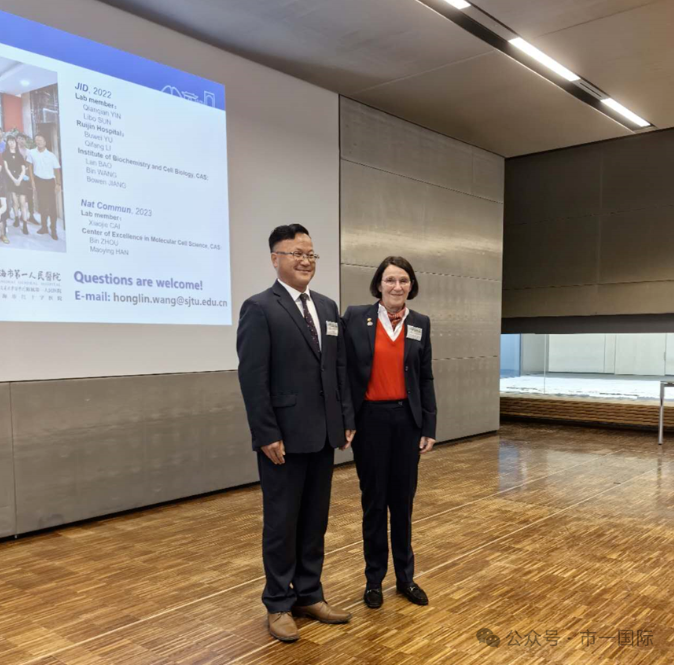
Professor Stephan Stilgenbauer, Head of the Comprehensive Cancer Center Ulm, presented the significant advancements in the research of chronic lymphocytic leukemia (CLL) pathogenesis and the related drug development projects over the past two decades. The use of BTK inhibitors, PI3K inhibitors, and BH3 mimetics has fundamentally transformed CLL treatment and significantly improved patient outcomes. Additionally, novel and improved anti-CD20 antibodies have been developed, enhancing the efficacy of chemoimmunotherapy while proving to be valuable combination agents with new BCR pathway inhibitors and BH3 mimetics in numerous ongoing clinical trials. The extensive clinical trials conducted by Professor Stilgenbauer and his team have brought curative treatment for CLL closer to reality.
My student, Researcher Fangzhou Lou, presented the latest research findings on catecholaminergic neural regulation of keloid fibroblast function. She identified the β1-adrenergic receptor as a crucial therapeutic target for keloids and shared preliminary positive results from an IIT using a β-blocker cream to treat hypertrophic scars. These research outcomes received high acclaim from Professor Scharffetter-Kochanek, Head of the Department of Dermatology at Ulm University Medical Center, and Professor Tuckermann, Head of the Institute of Comparative Molecular Endocrinology.
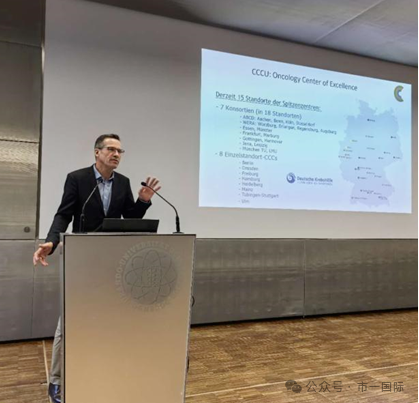
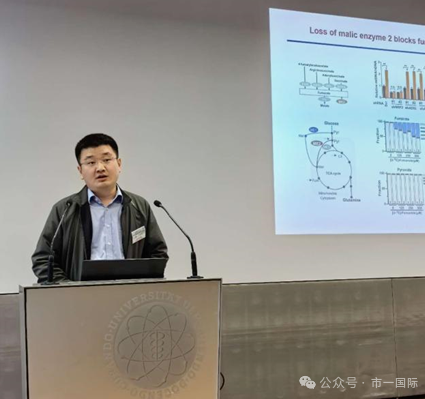
Professor Jan Tuckermann, Head of the Institute of Comparative Molecular Endocrinology at the University of Ulm, delivered an academic presentation titled "Steroid Regulation of Immunometabolism." He eloquently introduced the recent findings of his research team on the role of steroid metabolism in mitochondrial function and immune cell activity. Researcher Wang Yiping from our hospital shared research outcomes on the metabolic regulation of mitochondrial transcription during the academic report. During the Q&A session and conference breaks, Researcher Wang and Professor Tuckermann exchanged insights on mitochondrial regulation, engaging in lively discussions on the molecular biological mechanisms governing mitochondrial size and dimension. They also explored the physiological and pathological significance of organelle function remodeling, including mitochondria, in disease models such as cancer and obesity.
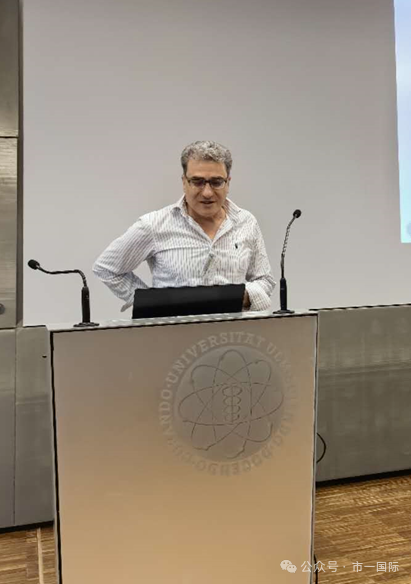
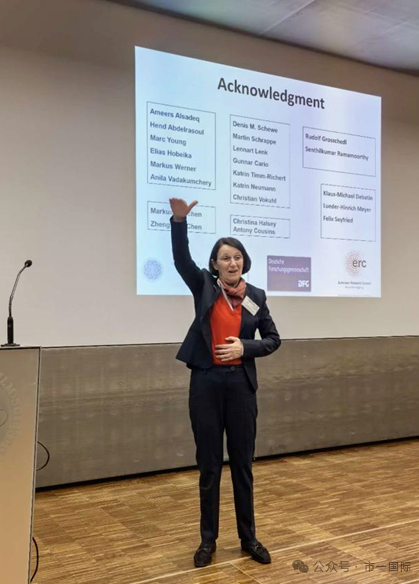
Principal Investigator Jun Wang from Shanghai General Hospital delivered an academic presentation titled "Autoreactive B Cell Response in Early Stage Tumorigenesis." Wang shared innovative findings on how chronic inflammation in early endometrial cancer promotes the expansion of autoreactive B cells with attending experts.
Additionally, Professor Hassan Juuma, Head of the Immunology Institute at Ulm University Medical Center, presented an impressive report titled "The Role of the IL-7 Receptor in B Cell Lymphoblastic Leukemia." Professor Juuma introduced his research group's groundbreaking discovery on the interaction between IL7R, chemokine receptor CXCR4, and B cell receptor driving B cell precursor acute lymphoblastic leukemia (BCP-ALL), proposing new approaches for clinical treatment of ALL.
Besides actively participating in academic exchanges, our clinical team engaged in professional exchanges with relevant clinical departments. At 11 a.m., our Orthopedics Department Head Jinzong Ma joined Professor Heiko Reichel of the Orthopedics Department at Ulm University Hospital for a joint surgery and had in-depth discussions with the clinical team. Other experts from our delegation visited their corresponding departments for further exchanges after lunch. Deputy Director Liu Jun, Director Liu Fang, and Deputy Director of the Trauma Center Gu Song were led by Professor Florian Gebhard, Vice President of Ulm University Hospital, to visit the Trauma Center. They extensively discussed future clinical talent exchange programs between our hospital and Ulm University Hospital. Doctor He Xiaojin of our Reproductive Medicine Department visited the Women and Children's Hospital of Ulm University and its Reproductive Medicine Department. Associate Doctor Su Qi and Zhao Yingying of our Medical Affairs Department engaged in visits and exchanges with the Anesthesiology and Intensive Care Department of Ulm University Hospital. Our Cardiology Department Doctor Yang Wenyi and Geriatrics Department Doctor Li Hongli also participated in exchanges and learning sessions with the Cardiology Department of Ulm University Hospital.
On the evening of June 10th, the Ulm hosts held a welcome banquet to our hospital delegation at the historic Ulm City Hall restaurant, where both hosts and guests enjoyed a delightful evening. On June 11th, the clinical delegation visited the Comprehensive Cancer Center at Ulm University Hospital and were warmly received by Professor Thomas Seufferlein, the center's head. Concurrently, I led the research delegation to the Dermatology Department at the Medical School for in-depth discussions on research topics, where both sides constructively exchanged opinions and suggestions.
From June 12th to 14th, our hospital delegation moved to Munich, focusing on exchanges and visits at the renowned Isar Right Bank Hospital affiliated with the Technical University of Munich. On the morning of June 12th, the delegation was warmly welcomed by Professor Peter Biberthaler, Head of the Trauma Surgery Department, and attended a hip replacement surgery. In the afternoon, there was an academic exchange session centered on clinical topics. In the evening, the hosts held a welcoming banquet for the delegation at Munich’s famous beer garden.
On the morning of June 13th, Doctor Yang Wenyi, Li Hongli, and Su Qi observed a cardiac surgery at the Munich Heart Center, followed by participation in other academic activities in the field of cardiology with the rest of the delegation. At noon, the delegation met with the management of the Technical University of Munich Hospital to discuss future cooperation plans.
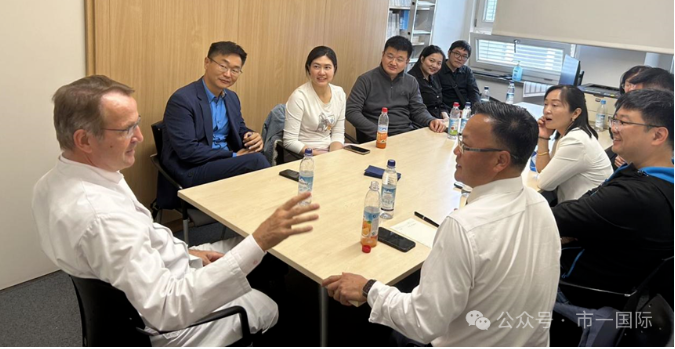
On June 14, a delegation led by Doctor Dommasch of the Emergency Department visited the Emergency Department and the Oncology Translational Research Center at Munich Technical University Hospital. Doctor He Xiaojin visited the Reproductive Endocrinology Department at the affiliated Hadena Hospital of Munich University, where he met with the department head, Professor Christian J. Thaler, Vice President of the European Society of Gynecology and Obstetrics. They engaged in a pleasant and in-depth discussion and jointly attended to over a dozen outpatient cases. I led a research team and Vice Director Doctor Gu Song of our hospital's Trauma Center to visit the Plastic and Hand Surgery Department at Munich Technical University Hospital. We had a very in-depth and meaningful meeting with the department head, Professor Hans-Günther Machens, thoroughly discussing comprehensive bilateral cooperation plans in both research and clinical areas. Professor Machens expressed interest in sending experts to our Clinical Research Institute later this year to conduct animal experiments on diabetic foot, and we also explored the possibility of the German team conducting partial clinical trials on pediatric burns at our hospital.
Through this visit to Ulm and Munich in Germany, the delegation achieved significant results in both academic and clinical exchanges and reached several consensuses on practical operations and future cooperation plans.
Summary
This visit was a very successful and fruitful academic and clinical exchange journey. Through in-depth exchanges with top German universities and hospitals, our hospital expanded its horizons in multiple research fields and clinical practices, gaining valuable experience and insights.
This visit not only strengthened our academic ties and cooperation with Ulm University and Munich Technical University but also laid a solid foundation for future scientific and clinical collaboration. Face-to-face exchanges deepened mutual understanding, clarified common research interests and clinical challenges, and discussed specific cooperation projects and plans.
Looking ahead, our hospital will continue to strengthen collaboration with top German universities and hospitals, promoting mutual progress in research and clinical fields. Specific cooperation plans include joint applications for international research projects, conducting joint clinical trials, and exchanging experts and scholars for short-term and long-term exchanges. We look forward to overcoming medical challenges together through these collaborations, improving healthcare services, and providing better medical services to patients.
This visit was not only an academic and clinical exchange but also a deep expansion of friendship and cooperation. We believe that with the joint efforts of both parties, future cooperation will be broader and deeper, making greater contributions to the development of medical science and the health of humanity.

Honglin Wang
Executive Vice President, Clinical Research Institute, Shanghai General Hospital; Distinguished Professor and Ph.D. Advisor, Shanghai Jiao Tong University; Deputy Director, Skin Immunology Branch, Chinese Society of Immunology; Recipient, National Outstanding Youth Science Fund (2017); Chief Scientist, Ministry of Science and Technology Key Research and Development Program (2020).
Dr. Honglin Wang's research focuses on dermatological immunology, with a particular emphasis on developing novel therapeutic compounds. He has pioneered the discovery of new compound structures and targets for the treatment of psoriasis and vitiligo, leading to the development of a “First in Class” national class I candidate drug molecule currently undergoing Phase II clinical trials.
His work has been extensively published, with over 70 papers in prestigious international journals such as Immunity, boasting a cumulative impact factor of 630 and approximately 4200 citations. Dr. Wang holds 12 national invention patents and 3 PCT patents. Notably, his patent related to the "Immune Age Diagnostic Kit" was transferred for a record sum of 600 million RMB, with an initial payment of 30 million RMB, setting a precedent for the highest initial payment received by a medical institution in Shanghai.
Dr. Wang is the chief scientist for one Ministry of Science and Technology Key Research and Development Program project. He also leads one National Outstanding Youth Science Fund project, one National Natural Science Foundation of China Original Exploration project, two National Natural Science Foundation of China Key projects, one sub-project of the Ministry of Science and Technology 973 project, one National Natural Science Foundation of China Major Research Plan (Cultivation) project, and two General Program projects. Additionally, he has been awarded several city-level, bureau-level, and university-level research projects, including the Shanghai Excellent Academic Leader Award, the Shanghai Shenkang Hospital Development Center Five New Projects, the Shanghai Pujiang Talent Program, the Shanghai Jiao Tong University STAR Program, and the Shanghai Jiao Tong University Integrated Innovation Fund, with a total funding amounting to 44.22 million RMB.
